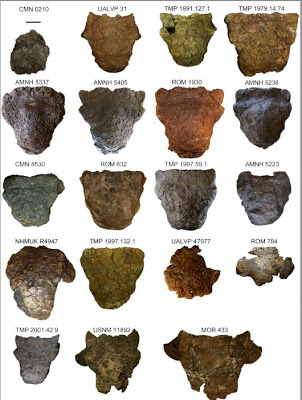
Just when dinosaur researchers thought they had a thorough knowledge of ankylosaurs, a family of squat, armour plated, plant eaters, along comes University of Alberta graduate student, Victoria Arbour.
Arbour visited dinosaur fossil collections from Alberta to the U.K. examining skull armour and comparing those head details with other features of the fossilized ankylosaur remains. She made a breakthrough that resurrected research done more than 70 years ago.
Arbour explains that between 1900 and 1930 researchers had determined that small variations in the skull armour and the tail clubs in some ankylosaurs constituted four individual species of the dinosaurs.
“In the 1970s the earlier work was discarded and those four species were lumped into one called species Euoplocephalus,” said Arbour.
“I examined many fossils and found I could group some fossils together because their skull armour corresponded with a particular shape of their tail club,” said Arbour.
Finding common features in fossils that come from the same geologic time is evidence that the original researchers were right says Arbour. “There were in fact four different species represented by what scientists previously thought was only one species, Euoplocephalus.”
The four species span a period of about 10 million years. Arbour’s research shows three of those ankylosaurs species lived at the same time in what is now Dinosaur Provincial Park in southern Alberta.
Arbour says this opens the door to new questions.
“How did these three species shared their habitat, how did they divide food resources and manage to survive?” said Arbour.
Arbour will also look into how slight differences in skull ornamentation and tail shape between the species influenced the animals’ long reign on Earth.
Arbour’s research was published May 8, in the journal PLOS ONE.
Note : The above story is reprinted from materials provided by University of Alberta, via EurekAlert!, a service of AAAS.










